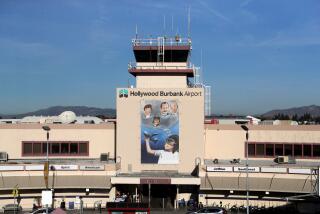10,000 Critics Sign Petitions Protesting Airport Noise
Representatives from six Valley-area homeowner groups opposed to noise and air pollution at Burbank Airport delivered more than 10,000 signatures of âoutragedâ residents to Rep. Howard Berman (D-Panorama City) at his Valley office Friday.
The signatures--collected at grocery stores, shopping centers and in neighborhoods from Encino to Sunland--are aimed at debunking persistent criticism by some airport and government officials that airport opponents are limited to a handful of vocal residents living near it.
Petitions were circulated last summer and autumn by members of the the East Valley Homeowners Coalition, an association of resident groups from the San Fernando Valley and Burbank. The coalition was organized several years ago to oppose noise pollution at the airport and increased commercial flights, which averaged about 45 a day in the late 1970s and now exceed 75 a day.
âThe East Valley is being bombarded with noise,â said Richard G. Sorenson, chairman of the petition drive, at a press conference with Berman. âThese are to present you with a body of evidence to use, to show the seriousness and extent of the problem, and the magnitude of injustice.â
Berman Called Their Champion
Berman, who was described by coalition members as a âchampionâ for residents in their past struggles with the airport, swept 10 rolled bundles of petitions into his arms and pledged to âkeep fightingâ in Washington with his new ammunition.
The two-term congressman wrote an amendment to a federal transportation appropriations bill in 1983 in an effort to block federal funds for a proposed new terminal building at the airport until the Burbank-Glendale-Pasadena Airport Authority completed a noise abatement plan. The amendment was intended to aid the City of Los Angeles, which subsequently sued the airport authority to prevent construction of the terminal.
The suit, based on fears that the new terminal would lead to more air traffic and noise, was rejected last year by a Los Angeles Superior Court judge. The Los Angeles City Council voted in September not to appeal the decision after the authority agreed to attempt to reroute some departing flights away from some neighborhoods in the Valley.
Federal Approval Required
But that compromise--which would reroute flights from the Valley to east Burbank and Glendale--requires the approval of the Federal Aviation Administration, which is only now studying the proposal.
The airport authority, meanwhile, will select an architect and engineer within the next few months to draft a conceptual design for the proposed terminal building, airport officials said. Officials are also negotiating with the Lockheed Corp. to purchase 40 acres of Lockheed land at the northeast corner of the airport for the terminal.
Airport officials have said that the new terminal is needed to comply with a federal regulation requiring that the distance between terminals and runways be at least 750 feet. Portions of the existing terminal are only 313 feet from a runway.
Airport spokesman Victor J. Gill said that the authority has not yet determined how it will pay for the terminal, the estimated cost of which ranges from $30 million to $60 million. âThe idea is to have it come from a variety of sources,â he said.
In September the airport authority accepted a $2.2-million federal grant toward purchase of the Lockheed land, money that was forwarded by the FAA only after the lawsuit with the City of Los Angeles was resolved.
Berman said the signature drive âre-energizedâ his commitment to work with officials from the Federal Aviation Administration and the Burbank Airport authority to find a balance between growing transportation needs in the Valley area and the rights of residents living near the airport to a âquality of life.â
âWhen 10,000 people in this day and age go public, we now have the kind of evidence we always believed existed,â Berman said. âI do not want to close the airport down. But I donât want to see it become a new national or international airport.â
Berman said he favors using both the north-south and east-west runways at the airport for departing aircraft to better distribute aircraft noise (planes now depart almost without exception from the north-south runway), establishing a ceiling on the number of flights at the airport, and moving exclusively to the use of quieter jets.
Not Opposed to Terminal
Berman said he would not oppose the construction of a new terminal building at the airport if it could be built âon the basis of equal runway utilizationâ and was not used as a means to increase the number of flights. Airport officials estimated several years ago that the new terminal could accommodate a 6% annual growth of airport operations for five years after it was built.
The petitions, which asked elected officials to âdo something about the noise and air pollution generated by the Burbank Airport activities,â were intended to show skeptics that the adverse impact of noise, air pollution and vibration has been drastically increasing in the Valley, Sorenson said.
The homeowners contend that the airport affects Valley residents far beyond the neighborhoods in Burbank, Sun Valley and North Hollywood that lie adjacent to it.
âI have had the opportunity to listen to hundreds of residents from Sunland to Encino and from Burbank to Van Nuys relate their experiences, concerns and outrage regarding the Burbank Airport,â Sorenson said in a prepared summary of problems at the airport. âI only regret that I am unable to communicate the depth and intensity of their emotions and feelings on the subject.â
Berman said that he will show the petitions to other members of Congress from the Los Angeles area, Sens. Alan Cranston and Pete Wilson, members of the Burbank Airport Authority and FAA officials.
The petitions, he said, will give him power in Washington to use the federal allocation process as a âbargaining chipâ when the airport authority seeks federal assistance for construction of the new terminal building.
More to Read
Sign up for Essential California
The most important California stories and recommendations in your inbox every morning.
You may occasionally receive promotional content from the Los Angeles Times.










